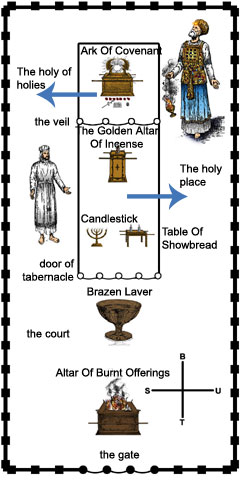

Exodus
30: 1-10
Exodus 37: 25-29
PS:
- 2 staves/poles overlaid with gold
- 4 rings of gold
- 4 horns overlaid with gold upon its four corners
- a crown of gold
- a golden censer containing incense
The square Altar of Incense was made shittim/acasia wood overlaid with
gold.
Its measurements:
- length : 1 cubit
- width : 1 cubit
- height : 2 cubits
The Altar was square
and had 4 horns overlaid with gold. It had 4 golden rings, 2 on each side
to hold the 2 staves/poles of shittim/acasia wood overlaid with gold used
to carry it. It was placed in the front of the veil that was by the Ark
of Testimony before the mercy seat that was over the Testimony.
Aaron, the high priest, had to burn sweet incense on the altar every morning
when he tended the lamps, and when he lighted the lamps in the evening,
he had to burn it again, a perpetual incense before the Lord.
The following were not allowed to be offered on the Altar of Incense:
- strange incense
- burnt offering
- meat offering
- drink offering
THE SPIRITUAL MEANING
The word “Altar”
was derived from the Latin word “Altare” which means
“a high fireplace”.
The Altar of Incense denotes an elevated place were the smoke of
the incense rose heavenward, so that God and man could meet and
have fellowship.
The burning of incense signifies prayer/worship (Psalm 141:2;
Luke 1:10; Revelation 5:8; 8:3-4)
The Altar was made of shittim/acasia wood overlaid with gold.
The Church, similarly, must be an altar of prayer full of the Holy
Spirit. This signifies that prayer must not be offered by our own
strength or ability, nor should it be offered because of duty or
force, for such prayer is doomed to barrenness (spiritual death)
Prayer must be completely surrendered to and controlled by the Holy
Spirit (Romans 8:26-27; Zechariah 12:10). The Church
must be a great altar of prayer, especially in these last days (Revelation
8:3-4)
The Altar
was square
Square refers to the four corners of the earth, signifying universal/world-wide
prayer (Malachi 1:11)
The task of the Church is to pray for all men (1 Timothy
2:1-4)
The crown of gold roundabout the altar refers to a holy and intense
fellowship through prayer.
The four golden horns overlaid with gold speak of divine power,
especially the power of salvation (Psalm 18:3; Habakkuk
3:3-4).
We receive this power by continuing steadfastly in prayers, resulting
in the tearing of the “veil” of our flesh.
The place
of the Altar
The Altar occupied a significant position in the Holy Place –
in front of the veil that was by the Ark of Testimony.
The veil is the image of the flesh.
When Jesus died on the Cross-, the veil was torn in two, from top
to bottom, leaving the way to the Ark of the Covenant – God’s
throne – Open! (Matthew 27:50-51; Hebrews 10:19-22)
Prayer is the way to crucify the flesh and its desires completely.
